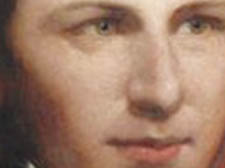|
|
 |
| |

Augustus Pugin |
Religious foundations of man who designed Big Ben
He may not be as famous as Brunel, but London was happy to put its faith in the talents of Augustus Pugin.
By Dan Carrier order this book
AUGUSTUS Pugin’s work has graced an infinite amount of postcards, tea towels and mugs. The product of his fertile imagination has become perhaps the most recognisable icon to represent the United Kingdom abroad.
But while great British designers such as Brunel or Morris are household names, Pugin, the man who designed Big Ben and much of the House of Lords, is little known.
Rosemary Hill, biographer of Pugin, will discuss his life and times with Hampstead journalist Andrew O’Hagan at the London Review Bookshop next week, and what emerges from the pages of her tome is a fascinating story of an architect who was driven by his deeply held Christian beliefs, who wanted to use his skills as a draughtsman to build an England fit for holy worshippers.
His legacy is all around us. As the father of the Victorian Gothic Revival, we would not have had such soaring landmarks as the
St Pancras Midland Hotel if he hadn’t established Gothic revival as one of the most important trends in Victorian building.
According to Hill, Pugin’s religion drove everything he sought to achieve. He wanted to return Britain back to Catholicism and considered the social structure of the Middle Ages as representing the country’s finest hours.
Pugin’s carefully researched background has everything a biographer could wish for. His early life was action-packed. He had been widowed by 21, as well as shipwrecked and bankrupted. His 20s were marked by a prodigious building spree which left a legacy of 22 churches and three cathedrals. He was dead by 40, driven insane by syphilis.
He had no formal education, but instead spent much of his early years touring medieval buildings with his father, who taught drawing and encouraged his son to sketch the places they visited. Aged just 15, he was commissioned to design a set of chairs for George IV at Windsor.
He was drawn to the theatre, and worked as a set designer in Covent Garden. Hill finds similarities between his stage designs and the churches he was to build – he was a set piece designer. His home in Salisbury included a drawbridge, turrets and a moat.
This design agenda stemmed from his own deep, religious feeling. He believed Gothic styles paid homage to his God’s glory, and he spawned imitators whose works can be seen across our towns, making our banks and railway stations, our civic offices and libraries grand imitations of the Victorian church.
|
 |
|
 |
 |
|
 |
|



